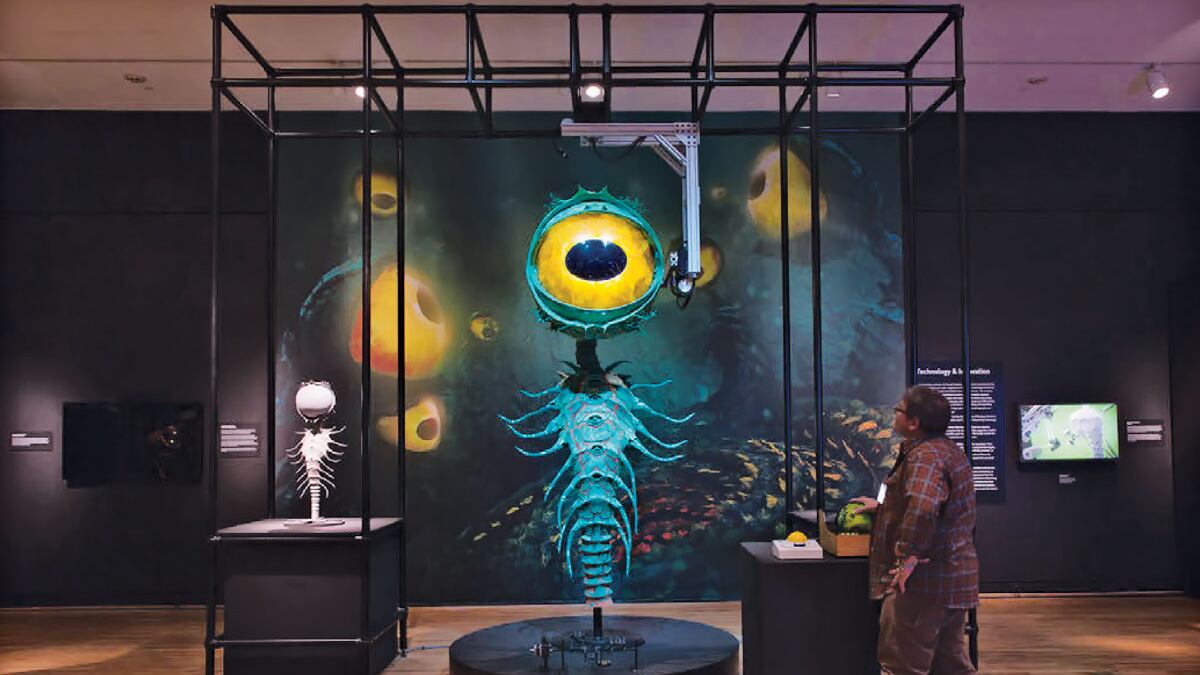A few years ago, LAIKA had a problem. The Hillsboro-based animation studio needed a giant skeleton for their most recent stop-motion film, Kubo and the Two Strings. To get the scale right, they couldn't just make the other puppets smaller, since they'd be too small for any kind of expressive detail. Most other studios would just use digital effects to create the difference in scale. But in their 12 years as a studio, LAIKA has handmade every piece of their movies, from the facial expressions in each still of dialogue to their highly detailed sets. So for Kubo, the studio decided to build the largest stop-motion puppet ever.
At 16 feet tall, it was too big to even move around LAIKA's studio—ultimately, they had to film the legs and torso separately. So Portland Art Museum's Animating Life: The Art, Life and Science of LAIKA is the first time the puppet has actually been in one piece. It stands at the entrance of the exhibit, with a glowing eye and illuminated with shadowy, dramatic uplighting.
Animating Life is the second animation exhibit PAM has ever held. After a recent exhibit in LA, it's the second time any art museum has paid tribute to the work of LAIKA. In many ways, it makes perfect sense—one of the city's most established art institutions playing tribute to one of Oregon's most imaginative and celebrated creators.
Related: LAIKA Is the Pride of Oregon Animation, So the Portland Art Museum Is Giving It Its Own Show
But Animating Life does seem unconventional. It looks more like a science museum exhibit than a traditional art show. The walls are painted black, the lights are low and creepy. There's a timeline of the history of stop-motion animation. There's a display of the metal skeleton each puppet is built from. There's an interactive section of the exhibit where you can operate a puppet and the rig LAIKA used to make the ocean waves in Kubo—sheets of blue paper topped with rugged white caps that fold over each other like dominos.
Animating Life is more about marveling than interpreting, but there's plenty to find marvelous. In the center of the exhibit is the set for the garden in Coraline. You don't need to have seen the movie to appreciate its opulence: illuminated cherry blossoms and glowing pumpkins, a bridge over a river covered in leaves and petals, and a hill covered with tiny blue flowers. It might even be more magical seeing it outside of the movie. Physically in front of you instead of on a screen, it feels completely real.
The genius of LAIKA's films is as much in their fantastical ambitions as it is in their details, which is something Animating Life constantly reminds you of. In the back center of the exhibit is LAIKA's first automated puppet, a green sea fern with a giant robotic eye. Up close, you can see the texture of foam under the puppet's green paint. Its wires and mechanical spine are exposed along its back. There's a control panel where you can move the puppet's head by rotating a bowling ball—due to an almost obsessive need to empathize with their work, the fern monster's creators wanted to have a physical sense of the puppet's giant eye as they controlled it, and a bowling ball was the closest approximation.
It might be the banal details of LAIKA's films that are the most mind blowing. Several sets are displayed throughout the exhibit, including the exterior of Norman Babcock's house from ParaNorman. Less than three feet tall, it's a rickety home in set the suburbs of New England, complete with disheveled plastic blinds, a stack of cinder blocks partially hidden beneath a bush, a milkcrate with overflowing paint tins and stacks of unused tan plant pots. You feel like you could reach out turn the tiny water spigot, which is sort of how you feel when you're watching LAIKA's movies, too. Ultimately, it's those tiny, dusty details that make LAIKA's films seem lifelike.
SEE IT: Animating Life: The Art, Life and Science of LAIKA is at Portland Art Museum, 1219 SW Park Ave., portlandartmuseum.org. Through May 20. Museum admission is $19.99 Tuesday-Sunday and $5 after 5 pm every Friday.
